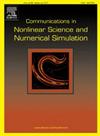地球轨道物体的半解析姿态传播
IF 3.4
2区 数学
Q1 MATHEMATICS, APPLIED
Communications in Nonlinear Science and Numerical Simulation
Pub Date : 2024-12-21
DOI:10.1016/j.cnsns.2024.108549
引用次数: 0
摘要
本文提出了任意形状地球轨道物体姿态运动长期传播的半解析理论。姿态动力学包括重力梯度、残磁和光压转矩的影响。运动方程用Sadov变量表示。在Sadov角和轨道平均异常上对运动方程进行平均,并应用李氏变换组合将非平均姿态变量转换为平均姿态变量。将展示如何使用这种技术来估计近似误差并提高平均解的精度。此外,我们引入了一组替代变量,它消除了Sadov变量公式中的一个奇异点。数值试验结果表明,所提出的半解析理论在计算精度和计算成本之间取得了很好的平衡。本文章由计算机程序翻译,如有差异,请以英文原文为准。
Semi-analytical attitude propagation for earth orbiting objects
This paper presents the development of a semi-analytical theory for the long-term propagation of the attitude motion of Earth-orbiting objects with arbitrary shape. The attitude dynamics includes the effects of gravity-gradient, residual magnetic, and light-pressure torques. The equations of motion are expressed in Sadov variables. The equations of motion are averaged over the Sadov angles and the orbital mean anomaly and a combination of Lie transformations is applied to transform from non-averaged to mean attitude variables. It will be shown how this technique can be used to estimate the approximation error and improve the accuracy of the averaged solution. Furthermore, we introduce an alternative set of variables, that removes one of the singularities in the formulation in Sadov variables. The results of the numerical tests demonstrate that the proposed semi-analytical theory, provides a good balance between accuracy and computational cost.
求助全文
通过发布文献求助,成功后即可免费获取论文全文。
去求助
来源期刊

Communications in Nonlinear Science and Numerical Simulation
MATHEMATICS, APPLIED-MATHEMATICS, INTERDISCIPLINARY APPLICATIONS
CiteScore
6.80
自引率
7.70%
发文量
378
审稿时长
78 days
期刊介绍:
The journal publishes original research findings on experimental observation, mathematical modeling, theoretical analysis and numerical simulation, for more accurate description, better prediction or novel application, of nonlinear phenomena in science and engineering. It offers a venue for researchers to make rapid exchange of ideas and techniques in nonlinear science and complexity.
The submission of manuscripts with cross-disciplinary approaches in nonlinear science and complexity is particularly encouraged.
Topics of interest:
Nonlinear differential or delay equations, Lie group analysis and asymptotic methods, Discontinuous systems, Fractals, Fractional calculus and dynamics, Nonlinear effects in quantum mechanics, Nonlinear stochastic processes, Experimental nonlinear science, Time-series and signal analysis, Computational methods and simulations in nonlinear science and engineering, Control of dynamical systems, Synchronization, Lyapunov analysis, High-dimensional chaos and turbulence, Chaos in Hamiltonian systems, Integrable systems and solitons, Collective behavior in many-body systems, Biological physics and networks, Nonlinear mechanical systems, Complex systems and complexity.
No length limitation for contributions is set, but only concisely written manuscripts are published. Brief papers are published on the basis of Rapid Communications. Discussions of previously published papers are welcome.
 求助内容:
求助内容: 应助结果提醒方式:
应助结果提醒方式:


